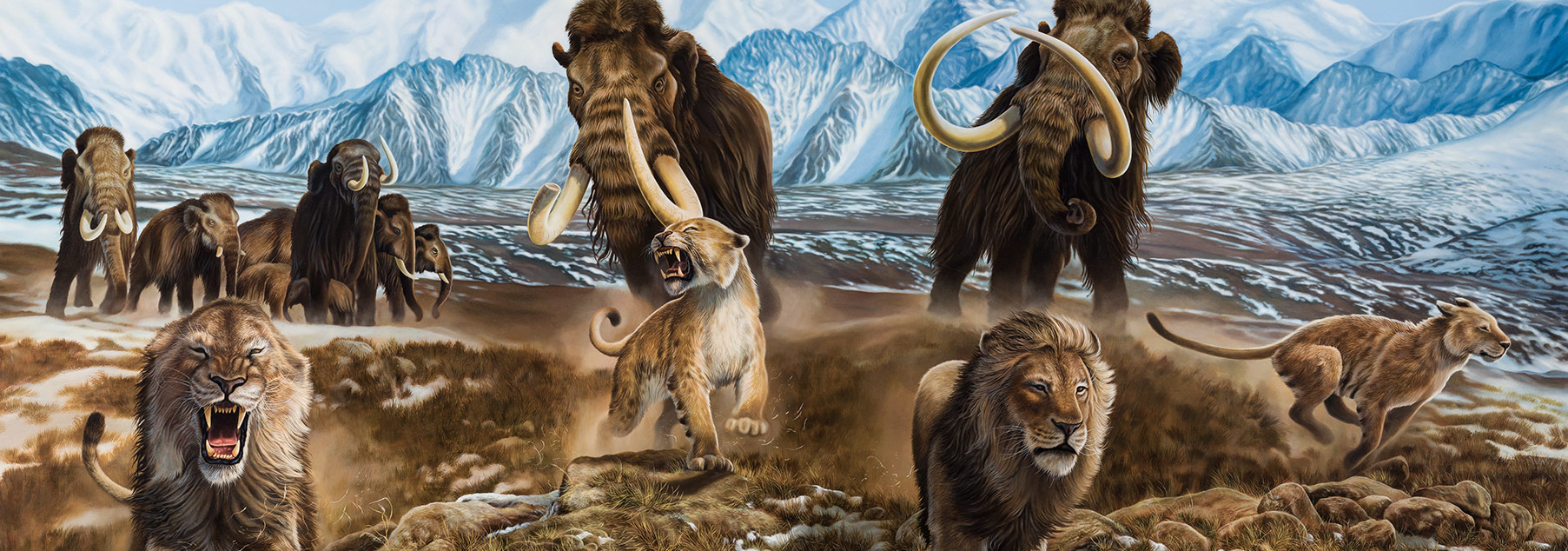We believe that art is a vital part of the experience our Centre offers; it allows us to visualize the wonders of this lost world. Art immerses us in the Beringian atmosphere, piques our interest and jump-starts our imaginations. It encourages us to ask questions and engage with history, to connect ourselves to the distant past and to each other in the present.
The art of the Beringia Centre has been created by a variety of local and non-local artists, all with different styles and backgrounds. Each work presents us with a fascinating narrative, either by focusing on the physical world as it once was, or by relaying traditional stories of our First Nation people. We are proud of the rich artistic and cultural community that Yukon has to offer, and we wish to share this enthusiasm with our visitors.
On this page you will find information about the unique artwork our centre has to offer and about the lives of the artists:
Depicting an Ancient World
Sharing Stories
Depicting an Ancient World
Much of the art in our centre is 'palaeoart': the depiction of extinct species and ancient landscapes. Palaeoartists, often working closely with palaeontologists, study the skeletal (and sometimes mummified) remains of an animal, compare it with similar species, and make an informed depiction of its appearance and habits. The practice can be difficult, since there are large gaps in our knowledge of certain extinct species. Despite these unknowns, artists are able to create viable and compelling models of what the past could have looked like. Palaeoart has inspired generations of budding scientists by transcending the boundaries of language, age and background.
We are lucky when it comes to constructing palaeoart of Beringia. We have been given extraordinary insight into ice age landscapes and creatures through well-preserved remenants of animal and plant life found frozen in northern permafrost. Wall murals and other palaeoart pieces accompany our displays to capture the atmosphere of the Ice Age.
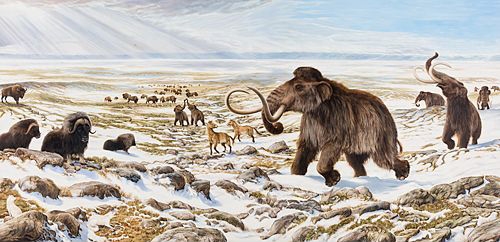
George Teichmann painter - Yukon and Czechoslovakia iceagebeasts.com
Born in Czechoslovakia and trained at the People's School of Art in Bohemia, George Teichmann began drawing ice age beasts as a little boy. He was greatly inspired by Czech artist Zdenek Burian who is considered a founding father in the field of palaeoart. George went on to study glass cutting but continued painting and exhibiting Pleistocene and modern wildlife art until he immigrated to Canada in 1983.
After several years of adventuring, including a 2500 mile solo canoe trip, he eventually settled in Yukon in 1991. The creation of the Beringia Centre provided George, now known by his artist's signature Rinaldino, with an ideal opportunity to continue painting his masterpieces. The Yukon government's Department of Tourism and Culture purchased a comprehensive collection of his work.
Paintings by George Teichmann are featured on our popular Beringia posters, and can be seen throughout this website. They depict the vast Beringian landscape and its impressive flora and fauna. George also painted the background for the Strange and Familiar exhibit at the Centre.
Jan Vriesen muralist - Milaca, Minnesota

One of the most experienced exhibit painting specialists in the world, Jan is best known for his museum diorama murals. Jan's depiction of a Jefferson's Ground Sloth feeding brings to life the adjacent ground sloth skeleton in our Great Hall. We also want to acknowledge Jan and Deborah’s (his wife) contribution to a past exhibit. They collaborated on the mural for what was once known as the Yukon Horse diorama.
More of Jan's work can be found in prominent museums throughout Canada, the United States and Europe, including the Denver Museum of Nature & Science, and the Morris Thompson Cultural and Visitors Centre in Fairbanks, Alaska.
Lillian Loponen painter - Keno, Alaska and Whitehorse, Yukon loponenarts.com

Lillian lived and worked in Keno for many years prior to moving to Whitehorse where she is now a member of the Yukon Artists at Work cooperative gallery. Her powerful, haunting landscapes in both oil and watercolour are in the Royal Collection at Windsor Castle UK, the Yukon Permanent Art Collection, the Keno City Mining Museum, and the Whitehorse Canada Games Centre.
At the Beringia Centre, Lillian painted the stunning background for the Giant Short-faced Bear exhibit. In 2000, she was contracted to refurbish and paint the Riverbank Layers exhibit outdoors. In 2017 Lillian painted the background for the Saiga Antelope diorama.
Chris Caldwell painter - Whitehorse, Yukon caldwellart.com
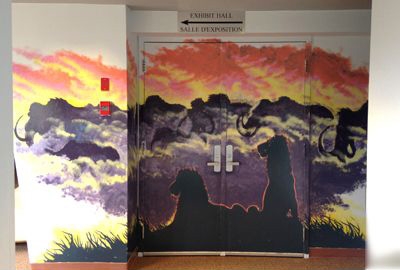
Chris has made the Yukon her home since 1979. Her humorous watercolour scenes of big game hunting, fishing, whitewater rafting, horseback riding and adventuring have delighted viewers for more than 30 years. Her pieces are inspired by real-life experience, as well as stories and photos from her clients. She captures the unique spirit and personality of each of her subjects.
Even thought Chris’ paintings are no longer displayed in the Beringia Centre, in many photos of the Beringia Centre you can see her talented works of art. For many years, her paintings brightened the theatre exit doors and the corridor to the back exhibit hall. With colour and vivid imagery, she captured the atmosphere of a windy, prehistoric steppe rich with ice age life.
Sharing Traditional Stories
Our exhibits incorporate artwork that builds an image of how North America's first people would have lived, and focuses on sharing some traditional stories of Yukon's First Nations people.
Halin de Repentigny painter - Dawson City, Yukon halinderepentigny.ca
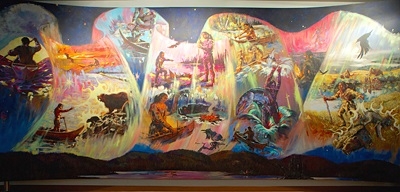
Halin was born in Montreal, Quebec and raised in Gaspé. He was influenced from childhood by French Canadian impressionists Maurice Lebon and Marcel Farreau. With no formal art training, but a keen interest and artistic ability, he began to paint at age 6 and by age 15 was exhibiting his work professionally. In 1981, following his childhood dream of becoming a trapper, Halin moved to Dawson City, Yukon where he has spent many years living in the bush running sled dogs, trapping and painting. His wilderness canvasses, scenes of historic Dawson City and caricatures of colourful local residents are in private collections, art galleries and public spaces all over Yukon, as well as the rest of Canada, the United States, Germany, Peru, Costa Rica and the Virgin Islands. Halin now divides his time between Yukon and Paragonia, Argentina.
Two of Halin's works were chosen by a committee of First Nations elders, Yukon arts community representatives, and Yukon government officials to be a part of the Beringia Centre. One of these pieces is the large, colourful mural of the legend of Ch'itahuukaii that can be found in our back hall.
According to Gwitchin legend, Ch'itahuukaii was a traveler who journeyed across the land, changing animals from giants and man-eaters into the familiar species we see today. It's possible that these stories reflect distant memories of ice age giants.
Mark Porter carver - Teslin, Yukon
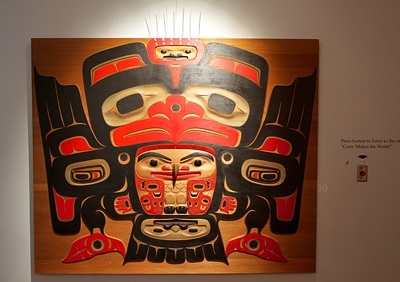
Keith Wolfe Smarch.
One of twelve siblings, Mark Porter was a member of the Kukhhitan (Raven) clan or the Teslin Tlingit Nation. He was also a grandson of well-known Tlingit photographer George Johnston. His clan name was Kanaash. Raised mainly in Teslin, Mark had a deep interest in his culture and learned the stories of his people from his mother. He was also a natural designer and carver.
At age 17 he began an apprenticeship with Keith Wolfe Smarch, and within five years he became Keith's artistic partner. Two of their collaborations are at the Beringia Centre: Where Legends Meet and Crow makes the World.
In 1999, Mark died in a house fire in Whitehorse - he was 28 years old. Mark's work is in the Aboriginal Art Centre in Ottawa, the Yukon Permanent Art Collection the Teslin Tlingit Heritage Centre, and private collections throughout Yukon and the rest of Canada.
Brian Walker carver - Whitehorse, Yukon
Brian came to the Yukon in 1969. He studied with artists Bill Reid, Dempsey Bob and Philip Jamze. He continued to learn from and work with Yukon artists Keith Wolfe Smarch and Mark Porter. In 1992, he began working with copper as an art material because of its ancient connections to Yukon history. He creates masks, bowls, and ceremonial pieces in copper, bronze and wood.
Brian is also keenly interested in heritage and historic canoes. He participated in he Lage Laberge Archaeology Project in 1995 be locating and recording a dugout canoe, likely more that 100 years old, for the Ta'an Kwach'an First Nation Council. He also worked on the Yukon Canoe Project in 2009, where nineteen carvers created the 30-foot red cedar dugout canoe now displayed at the Kwanlin Dun Cultural Centre in Whitehorse.
Keith Wolfe Smarch artist and carver - Carcross, Yukon keithwolfesmarch.com
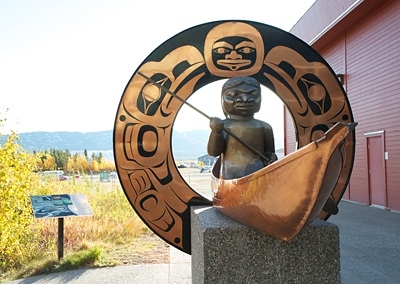
Mark Porter and Brian Walker.
Keith was born in Whitehorse, Yukon into the Dakh'lawêdi (Killer Whale) clan of the Teslin Tlingit First Nation. He is a descendant of and belongs to the same clan as Skookum Jim, who discovered gold in the Klondike in 1896. Keith's Tlingit name, Shakoon, means "mountain bird".
At age 20, he travelled to British Columbia to study under Tahltan Tlingit carver Dempsey Bob and Haida carver Freda Diesing. Keith continued his studies in Toyama, Japan with sculptor Haruki Fujii, working in wood and bronze.
In addition to his carving, Keith is passionate about teaching and passing on his knowledge through his art. He currently works from his studio in Carcross, Yukon. In the spring of 2013, he raised two Skookum Jim memorial poles - Killer Whale and Soaring Eagle - at the new Carcross Commons. His work is in the Yukon Permanent Art Collection, as well as in private collections and galleries throughout North America, Europe, and Japan.
Other talented artists who have contributed to our centre are:
Doug Taylor Livelong, Saskatchewan
Doug built the Winter Campsite diorama and painted the background.
Wei Lee Saskatchewan
Wei Lee painted the background for the Arctic Ground Squirrel exhibit.
Paul Geraghty Avonlea, Saskatchean
Paul painted the rocks and background for the life-sized Bluefish Caves exhibit.
Sabine Adams, Catherine Deer, Lorant Karnis and Jennie Lamont
These artists created the pen and ink illustrations which accompany the exhibit text throughout our Centre.

